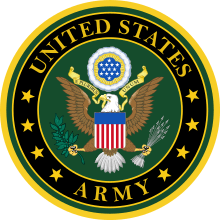United States Army officer rank insignia
United States Army Officer rank insignia in use today.
| US DoD Pay Grade | O-1 | O-2 | O-3 | O-4 | O-5 | O-6 | O-7 | O-8 | O-9 | O-10 | Special | Special | |
|---|---|---|---|---|---|---|---|---|---|---|---|---|---|
| Insignia |  |
 |
 |
 |
 | ||||||||
| Title | Second Lieutenant |
First Lieutenant |
Captain | Major | Lieutenant Colonel |
Colonel | Brigadier General |
Major General |
Lieutenant General |
General | General of the Army |
General of the Armies | |
| Abbreviation | 2LT | 1LT | CPT | MAJ | LTC | COL | BG | MG | LTG | GEN | GA | GAS | |
| NATO Code | OF-1 | OF-2 | OF-3 | OF-4 | OF-5 | OF-6 | OF-7 | OF-8 | OF-9 | OF-10 | OF-11 | ||
Warrant Officers (WO) and Chief Warrant Officers (CW) in the US Military rank below officers but above officer candidates and enlisted servicemen. The first warrant officer rank, WO1 does not have a "commission" associated with it, instead having a "Warrant" from the Secretary of the Army. Warrant officers are allowed the same courtesies as a commissioned officer, but may have some restrictions on their duties that are reserved for commissioned officers. Warrant officers usually receive a commission once they are promoted to Chief Warrant Officer 2 (CW2), but are usually not referred to as "commissioned officers". WO-1s may be and sometimes are appointed by commission as stated in title 10USC.
| US DoD Pay Grade | WO1 | CW2 | CW3 | CW4 | CW5 | |
|---|---|---|---|---|---|---|
(Edit) |
||||||
| Warrant Officer 1 |
Chief Warrant Officer 2 |
Chief Warrant Officer 3 |
Chief Chief Warrant Officer 4 |
Chief Warrant Officer 5 | ||
History
1775–1780: cockades or sashes
The structure of United States military ranks had its roots in British military traditions, adopting the same or similar ranks and titles. At the start of the American Revolutionary War in 1775, the Continental Army's lack of standardized uniforms and insignia proved confusing for soldiers in the field. To correct the situation, at least in the short term, General George Washington recommended the following stopgap solution for distinguishing the ranks:
"As the Continental Army has unfortunately no uniforms, and consequently many inconveniences must arise from not being able to distinguish the commissioned officers from the privates, it is desired that some badge of distinction be immediately provided; for instance that the field officers may have red or pink colored cockades in their hats, the captains yellow or buff, and the subalterns green."[1]
Generals wore a sash diagonally across their shoulders between their coats and waistcoats. Brigadier generals wore a purple sash, major generals a pink sash, and George Washington as commander in chief, wore a light blue sash. Aides-de-camps (mostly with the rank of captain) to officers of general grades wore a green sash.[2]
1780–1821: epaulettes
In 1780, regulations prescribed fringed epaulettes for all officer ranks, with silver stars for general officers.[3] Field officers wore two epaulettes, captains one epaulette on the right shoulder, subalterns one epaulette on the left shoulder.
1821–1832: chevrons or epaulettes
From 1821 to 1832, the Army used chevrons to identify company officer grades, a practice that is still observed at West Point for cadet officers. Adjutants were indicated by a single point up gold (infantry: silver) lace chevron and arc on both upper sleeves, captains the same but no arcs, lieutenants wore the chevrons on the lower sleeves. All company officers wore dark blue "wings" with gold (infantry: silver) fringes and Embroidery.
General Staff, artillery, engineer and field officers wore bullion fringed epaulets: Generals with silver eagle insignia and one or two five-pointed stars, depending on rank. Colonels wore the silver eagle (infantry: gold) insignia as well, lieutenant colonel and major identic plain gold (infantry: silver) epaulets. Captains a single epaulet on the right shoulder, lieutenants on the left shoulder.[4]
1832–1851: epaulettes and slashflaps vs. shoulder straps (1836)
In 1832, epaulettes were specified for all officers (see above). The epaulettes worn by the infantry were silver, while all other branches had gold epaulettes. In order that the rank insignia would be clearly discernible, they were of the opposite color; that is, the infantry colonels had an eagle of gold because it was placed on a silver epaulette and all other colonels had silver eagles on gold epaulettes. [3] The grade of Adjutant was abolished and the Lieutenant grade separated into two grades (First and Second Lieutenant). For the first time, a fatigue or undress uniform was introduced. The so-called "passants", shoulder straps holding the epaulets, were used to develop a new system of rank insignia.[4]
In addition, there was on the cuffs a slashflap with several horizontal rows of lace with a button on the outer ends. The lace was of yellow colour (infantry, white). Field officers wore four flaps and buttons, captains wore three, lieutenants wore two.[4]
In 1836, shoulder straps were adopted to replace the epaulette for field duty. The straps followed the same color combination as the epaulettes; that is, the border was gold with silver insignia for all officers except those of infantry which had silver border with gold insignia. At that time, lieutenant colonels and majors were authorized leaves, captains were authorized two bars, and first lieutenants were authorized one bar on the shoulder straps.[3]
1851–1872: epaulettes vs. shoulder straps
In 1851, it was decided to use only silver eagles for colonels, as a matter of economy. The silver eagle was selected based on the fact that there were more colonels with the silver eagle that those with gold, primarily in the cavalry and artillery, hence it was cheaper to replace the numerically fewer gold ones in the infantry. At that time on the shoulder straps, lieutenant colonels wore an embroidered silver leaf; majors wore a gold embroidered leaf; and captains and first lieutenants wore gold bars. The second lieutenant had no grade insignia, but the presence of an epaulette or shoulder strap identified him as a commissioned officer.[3] For majors, the shoulder strap contained an oak leaf, but like the second lieutenant, the epaulette had no grade insignia. However, the major was still distinguishable from the second lieutenant due to the more elaborate epaulette fringes worn by field grade officers.
Prior to 1851 the Infantry wore shoulder straps that had a silver border with gold insignia, the other branches wore gold border with silver insignia. The rank of major and lieutenant colonel were designated by oak leaves. A lieutenant colonel was determined by the color of the border, so an Infantry Lt. Col. wore silver oak leaves, and other branches wore gold oak leaves. In 1851 the Army did away with the Infantry distinction, everyone going to gold borders. Senior officers, Lieutenant Colonel, Colonel, and General wore silver insignia. Second Lieutenant had no rank, First Lieutenant, Captain, and Major wore gold insignia. In 1872 the ranks of First Lieutenant and Captain reverted back to silver insignia.
1872–1917: shoulder straps
In 1872, epaulettes were abolished for officers and replaced by shoulder knots. As the shoulder knots had no fringe, it was necessary that some change in the insignia on the dress uniform be made in order to distinguish the major from the second lieutenant. It was natural to use the gold leaf which the major had been wearing on the shoulder strap. In the same year, the bars on the shoulder straps of the captains and first lieutenants were changed from gold to silver.[3]
1917–2014: shoulder loops
By 1917 and the time of World War I, the olive drab service uniform had gradually become used more frequently and the blue uniform was worn only on formal dress occasions. As a result, metal insignia was authorized for wear on the service uniform on the shoulder loop and on the collar of the shirt when worn without a jacket. Shortly after the United States entered the war, only the service olive drab uniform was being worn. The need for an insignia for the second lieutenant became urgent. Among the proposals was one to authorize for that grade a single bar, the first lieutenant two bars, and the captain three bars. However, the policy of making as little change as possible prevailed, and a gold bar was adopted in 1917, following the precedent previously established by the adoption of the major’s insignia.[3]
In 1944, officers and enlisted personnel in leadership positions started wearing Leader Identification badges - narrow green bands under their rank insignia; this was initially approved as a temporary measure for European Theater of Operations, but was approved for select branches in 1945 then for the entire Army in 1948.[5] [6]
Silver versus gold
In terms of heraldic tradition, these changes created the curious situation of silver outranking gold. One anecdotal explanation suggested by some NCOs is that the more-malleable gold suggests that the bearer is being "molded" for his or her responsibilities—as a junior company grade officer (while a second lieutenant) or a junior field grade officer (while a major). Another rationale, perhaps originally devised as a tool for recruits to sort out the confusion, proposed that the symbolism was expressed as proximity to the heavens. Gold metal is denser, thus deeper in the ground, than silver, followed by leaves on a tree above the metals, with eagles flying above the trees, and finally the stars in the firmament. In actuality, the precedence of silver outranking gold was a consequence of the decision in 1851 to select silver over gold as a matter of economy.[3]
General of the Army / Armies
While not currently in use today, special insignia were authorized by Congress for ten general officers who were promoted to the highest ranks in the United States Army: general of the army, designed as a "five-star" rank, and general of the armies, considered to be the equivalent of a "six-star" rank. Eight generals were promoted to the rank and title General of the Army (Ulysses S. Grant, William Tecumseh Sherman, Philip Sheridan, George Marshall, Douglas MacArthur, Dwight D. Eisenhower, Henry H. Arnold, and Omar Bradley), while two generals were promoted to the higher rank and title of General of the Armies of the United States (George Washington and John J. Pershing).
Congress created the rank of general of the armies specifically for Washington, although while living he never officially accepted the honor. Pershing received the rank in 1919 and was allowed to choose his own insignia; he chose to use four gold stars. While a conjectural design for the rank of general of the armies was proposed using six silver stars when the promotion of Douglas MacArthur to the rank was considered in 1945, no design was ever officially authorized. In 1976, Congressman Mario Biaggi of New York submitted a house resolution granting Washington the promotion. The promotion was effective on July 4, 1976, the bicentennial of the Declaration of Independence. Although Pershing accepted the rank in 1919 and technically had a date of rank that preceded Washington's, the new law specified that no other officer of the United States Army should ever outrank Washington, including Pershing. Hence, effective date of rank notwithstanding, Washington was permanently made superior to all other officers of the United States Armed Forces, past or present.[7]
While no living officer holds either of these ranks today, the General of the Army title and five-star insignia designed in 1944 are still authorized for use in wartime. Congress may promote generals to this rank for successful wartime campaigns, or to give the officer parity in rank to foreign counterparts in joint coalitions, specifically with respect to field marshals.
| Period | 1866–1872 | 1872–1888 | 1919–1939 | 1942–present | 1956–present | ||||||
|---|---|---|---|---|---|---|---|---|---|---|---|
| Insignia | .svg.png) |
 |
 |
 | |||||||
| Title | General of the Army1 | General of the Army2 | General of the Armies3 | General of the Army4 | General of the Armies5 | ||||||
| 1 Worn by Grant (1866 to 1872). 2 Worn by Sherman (1872 to 1888) and Sheridan (1888). | |||||||||||
Former rank insignia
| NATO code | OF-10 | OF-9 | OF-8 | OF-7 | OF-6 | OF-5 | OF-4 | OF-3 | OF-2 | OF-1 | OF(D) | Student officer | ||||||||||||||||||||||||
|---|---|---|---|---|---|---|---|---|---|---|---|---|---|---|---|---|---|---|---|---|---|---|---|---|---|---|---|---|---|---|---|---|---|---|---|---|
(1959–2015) (Edit) |
.svg.png) |
 |
 |
 |
 |
 |
 |
 |
 |
 |
 |
Various | Various | |||||||||||||||||||||||
| (2010–2020) | Various | Various | ||||||||||||||||||||||||||||||||||
| General of the Army[note 1] | General | Lieutenant general | Major general | Brigadier general | Colonel | Lieutenant colonel | Major | Captain | First lieutenant | Second lieutenant | Officer candidate | Officer cadet | ||||||||||||||||||||||||
See also
Notes
- Title "General of the Army" is an honorary or posthumous rank, a war-time rank, or ceremonial rank.
References
- Garamone, Jim (1999). "Insignia: The Way You Tell Who's Who in the Military", DoD News, American Forces Press Service, United States Department of Defense, Washington, D.C. Retrieved March 3, 2018.
- Spencer Tucker, Almanac of American Military History, Vol.I (1000-1830), Santa Barbara (Calif.) etc. 2013, p.2329
- "Officer Insignia of Rank ~ Use of Silver and Gold", November 10, 2010, The Institute of Heraldry (Fort Belvoir, Virginia), Office of the Administrative Assistant to the Secretary of the Army, United States Department of the Army, Washington, D.C. Retrieved March 3, 2018.
- Perrenot, Preston B. (2011). United States Army Grade Insignia Since 1776 (Revised ed.). CreateSpace Independent Publishing Platform. ISBN 978-1448656875.
- https://www.armystudyguide.com/content/army_board_study_guide_topics/uniforms/leaders-identification-in.shtml
- https://mwi.usma.edu/201496genesis-of-the-army-green-tab/
- . 1976 – via Wikisource.
External links
- US Army Officer Ranks - United States Army website
- Use of Silver and Gold Officer Insignia of Rank The Institute of Heraldry
- US Army Rank and Insignia Courtesy of Georgia State Defense Force
- Department of Defense Rank Insignias — Officers Rank
